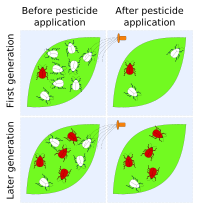
Photo from wikipedia
Head lice (Pediculus humanus capitis) are one of the most common insects causing infestations in humans worldwide, and infestation is associated with adverse socio-economic and public health effects. The development… Click to show full abstract
Head lice (Pediculus humanus capitis) are one of the most common insects causing infestations in humans worldwide, and infestation is associated with adverse socio-economic and public health effects. The development of genetic insensitivity (e.g., target site insensitivity = knockdown resistance or kdr) to topical insecticides has impaired effective treatment. Therefore, this study was undertaken to review and meta-analyze the frequency of pyrethroid resistance in treated head louse populations from the beginning of 2000 to the end of June 2021 worldwide. In order to accomplish this, all English language articles published over this period were extracted and reviewed. Statistical analyses of data were performed using fixed and random effect model tests in meta-analysis, Cochrane, meta-regression and I2 index. A total of 24 articles from an initial sample size of 5033 were accepted into this systematic review. The mean frequency of pyrethroid resistance was estimated to be 76.9%. In collected resistant lice, 64.4% were homozygote and 30.3% were heterozygote resistant. Globally, four countries (Australia, England, Israel, and Turkey) have 100% kdr gene frequencies, likely resulting in the ineffectiveness of pyrethrin- and pyrethroid-based pediculicides. The highest resistance recorded in these studies was against permethrin. This study shows that pyrethroid resistance is found at relatively high frequencies in many countries. As a result, treatment with current insecticides may not be effective and is likely the cause of increased levels of infestations. It is recommended that resistance status be evaluated prior to insecticide treatment, to increase efficacy.
Journal Title: Parasite
Year Published: 2021
Link to full text (if available)
Share on Social Media: Sign Up to like & get
recommendations!